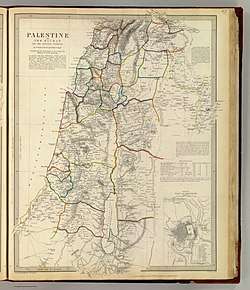Safad Sanjak

Safad Sanjak (Turkish: Safed Sancağı), also referred as Early Ottoman Galilee was a sanjak (district) of Damascus Eyalet (Ottoman province of Sidon) during 16th and early 17th centuries, later becoming part of the Sidon Eyalet.
Territory and demographics
The territory of Safad Sanjak consisted of the area between the Zahrani River in the north to Mount Carmel (near Haifa) in the south, and the area between the Sea of Galilee in the east and the Mediterranean Sea to the west. Besides Safad, it included the port cities of Acre and Tyre and the entire Galilee and Jabal Amil area. The district had a mixed population of peasants and Bedouin. The inhabitants of the Jabal Amil region were predominantly Shia Muslims, while the Galilee had a Sunni Muslim majority, including peasants and Bedouin, and a large Druze minority.[1] The district also contained Jewish communities.[2]
History
Prior to Ottoman rule, Safad was the capital of its own mamlaka (province) under the Mamluks. After its incorporation into the Ottoman Empire, Safad was reorganized into a smaller sanjak administratively part of the Damascus Eyalet (Damascus Province).[1] In 1547-48, Safad Sanjak contained a total of 287 villages.[3] In 1614, a new eyalet (province) was created based in Sidon, and Safad was annexed to it. The province was disbanded later that year and Safad Sanjak reverted to Damascus Eyalet. In 1660, the Sidon Eyalet was reestablished and Safad was once again annexed to it.[1]
Emir Fakhr ad-Din II controlled Safad Sanjak in the early 17th century and during his exile between 1613 and 1619, the Harfush clan tried and failed to gain control of it. Following the decline of Ma'ani rule in the late 17th century, the district largely came under the control of the Shihab dynasty.[4] The Shihabs entrusted administration of the district to the Zaydani clan. Under the Zaydani sheikh Zahir al-Umar, Safad Sanjak became the chief territory of Zahir's autonomous sheikhdom, although authority over the district largely transferred from Safad to Zahir's headquarters in Acre.
Administrative divisions
The Safad Sanjak was divided into the following five nawahi (sing.: nahiya; subdistricts):[3]
- Nahiya of Jira (Eastern Upper Galilee)
- Nahiya of Acre (Western Upper Galilee)
- Nahiya of Tiberias (Lower Galilee)
- Nahiya of Tibnin (Southeastern Jabal Amil)
- Nahiya of Shakif Arnun (Northeastern Jabal Amil)
References
Bibliography
- Abu Husayn, Abdul Rahim (2004). The View from Istanbul: Ottoman Lebanon and the Druze Emirate. I.B.Tauris. ISBN 9781860648564.
- David, Abraham; Ordan, Dena (2010). To Come to the Land: Immigration and Settlement in 16th-Century Eretz-Israel. University of Alabama Press. ISBN 9780817356439.
- Ellenblum, Ronnie (2003). Frankish Rural Settlement in the Latin Kingdom of Jerusalem. Cambridge University Press. ISBN 9780521521871.